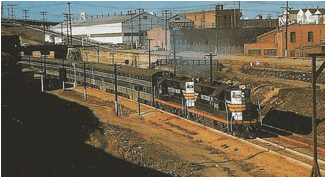Just a quick post since I’ve been doing lots of senior paper writing and haven’t put anything up here for a while…
As part of my senior paper research I’ve been looking quite a bit into the sociopolitical context of commuter/regional rail, and I’ve come across a number of interesting tidbits. Here’s an anecdote that’s worth sharing. It comes from the 1980 PhD dissertation of Sy Adler, today a respected professor at Portland State University, which is about the political economy of transit in the Bay Area in the immediate postwar era, especially the leadup to the building of BART.
In 1950 Southern Pacific found itself before the California Public Utilities Commission for the third time since the end of World War II to ask for a fare increase on its Penninsula Commute service–today’s Caltrain. As Adler tells it (pages 97-99):
SP had been facilitating the growth of “stockbroker suburbs” down the peninsula since the nineteenth century. Revenue patronage was slowly but steadily increasing on its trains between downtown San Francisco and San Mateo and Santa Clara Counties. However, despite the patronage gains and the previous fare increases the railroad claimed to be losing more than one million dollars per year in out-of-pocket operating costs alone. The fare increase SP was now proposing would only cut losses in half; the company believed it had already reached the point of diminishing returns in regard to increased fares.
The concentration of traffic on rush hour SP commuter trains was virtually complete. Seventy-five percent of the total movement to San Francisco traveled during the morning peak hour. Eighty-three percent of all passengers paid commutation fares to go downtown and back home. The railroad found that two-thirds of its locomotives and coaches utilized in peninsula passenger service were used for only three hours per day. All costs were increasing, as they were for every transit operator, with the exception of fuel oil (!)…[in short, the railroad was losing lots of money]…
A coalition of real estate interests, home builders and commuters opposed the SP fare increase proposal before CPUC. The opposition hired its own expert; he agreed that SP was losing money, but $340,000 less than the railroad claimed. The coalition was led by the David Bohannon organization, one of the largest real estate developers in the Bay Area. All protestants charged that increased fares would be a deterrent to home building and buying on the peninsula; property values would be threatened. The coalition argued that it was entirely appropriate for the SP to subsidize passenger train losses from profitable freight operations. This was the progressive thing to do.
One of the key elements to the argument that’s unfolding in my paper is that commuter rail, as an American mode, is heavily tilted toward the interested of the wealthy. This anecdote provides a fascinating example of that; rarely these days do we hear the Sprawl Machine arguing for better rail service. Rarer still is to hear them co-opt the language of Progressivism, still potent in California at the time, to make their point. But the coalition opposing the SP fare increase was more Growth Machine than Social Justice; it consisted of the landed wealthy and those who stood to profit from greater suburban development. And their agenda was not necessarily to improve SP service, but to continue its stasis as a mode that served the commute well, but could not provide comprehensive transit in the growing suburbs. In some ways, a lot has changed since then. But is this not still the underlying logic that supports the paradigm of “commuter” rail?
(feature image via trainweb.org)
